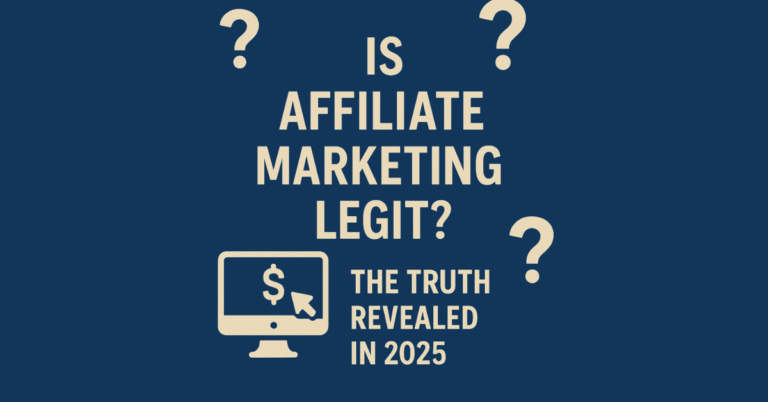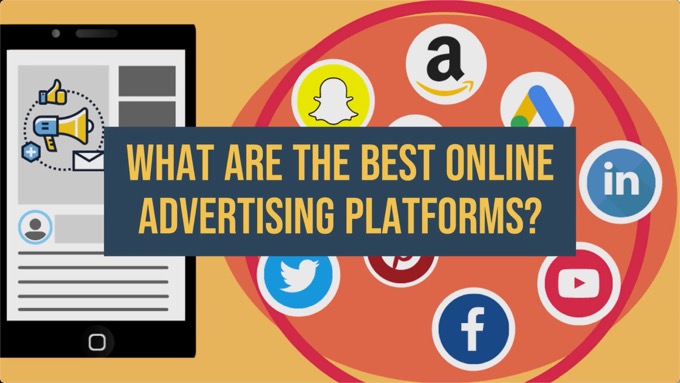How to Start Affiliate Marketing for Beginners (Step by Step)
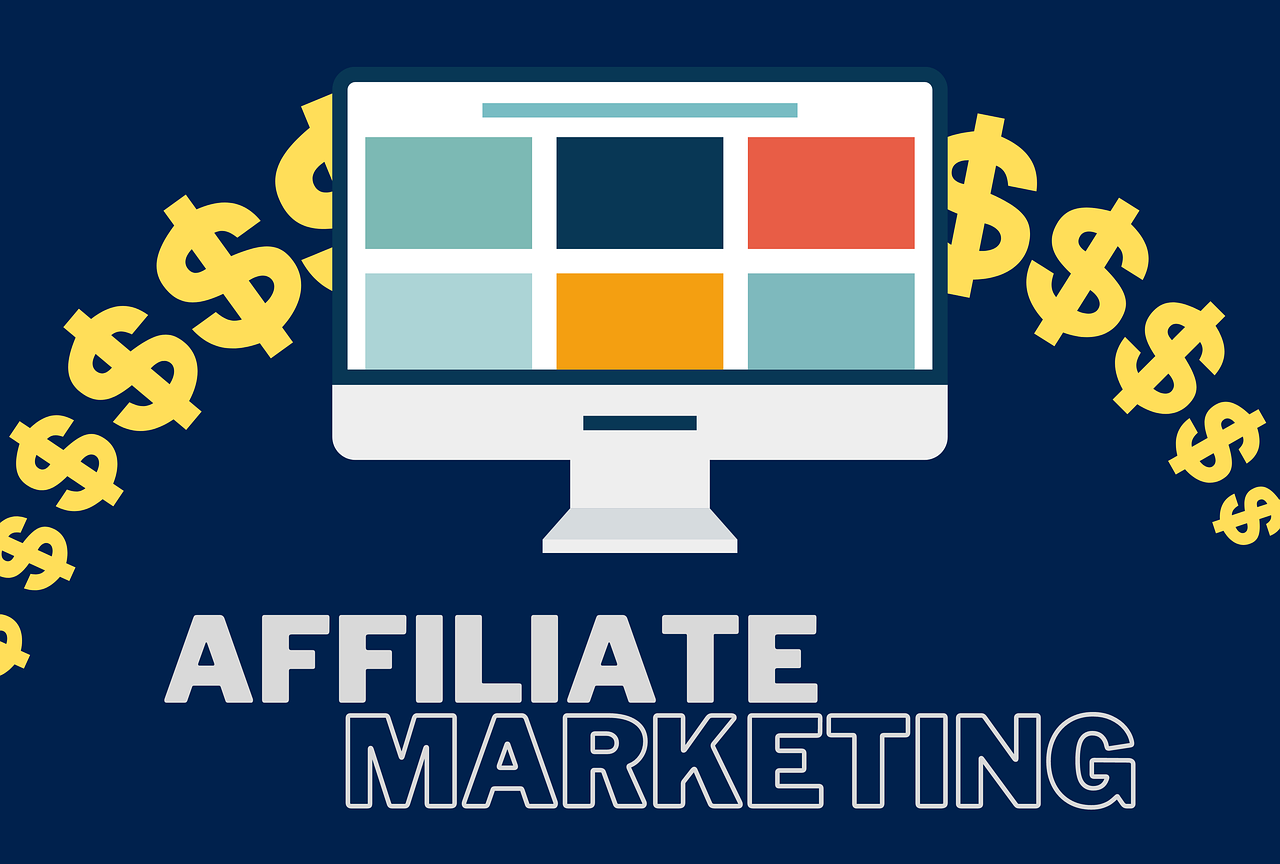
Learn the fundamentals of affiliate marketing for beginners with this guide. Discover how to choose profitable niches, find products to promote, and start earning passive income online.
Did you know that the global affiliate marketing industry is worth over $20 billion as of 2024 and that the average affiliate marketer earns $8,038 per month?
Whether you’re looking to create a side hustle or build a full-time online business, affiliate marketing offers an exciting path to earning passive income.
In this comprehensive guide, we’ll walk you through everything you need to know to start your affiliate marketing journey – no technical experience required!
What is Affiliate Marketing and How Does It Work?
Do you want to learn how to start affiliate marketing in 2025 and earn money online?
Let me share what I’ve learned after diving into this field years ago. Trust me, I made plenty of rookie mistakes that taught me exactly how this business model works!
First, let me break down affiliate marketing in the simplest way possible.
You know how you always tell friends about that amazing new coffee maker or those perfect running shoes you discovered? Affiliate marketing is basically that – but you get paid when people buy based on your recommendation. Pretty sweet deal, right?
Here’s how the whole system works:
Usually there are three key players involved in the whole process. You’ve got merchants who want to sell their products. Then there’s affiliates like you and me – we’re the ones who promote those products. And finally, there’s the customers who actually buy the stuff.
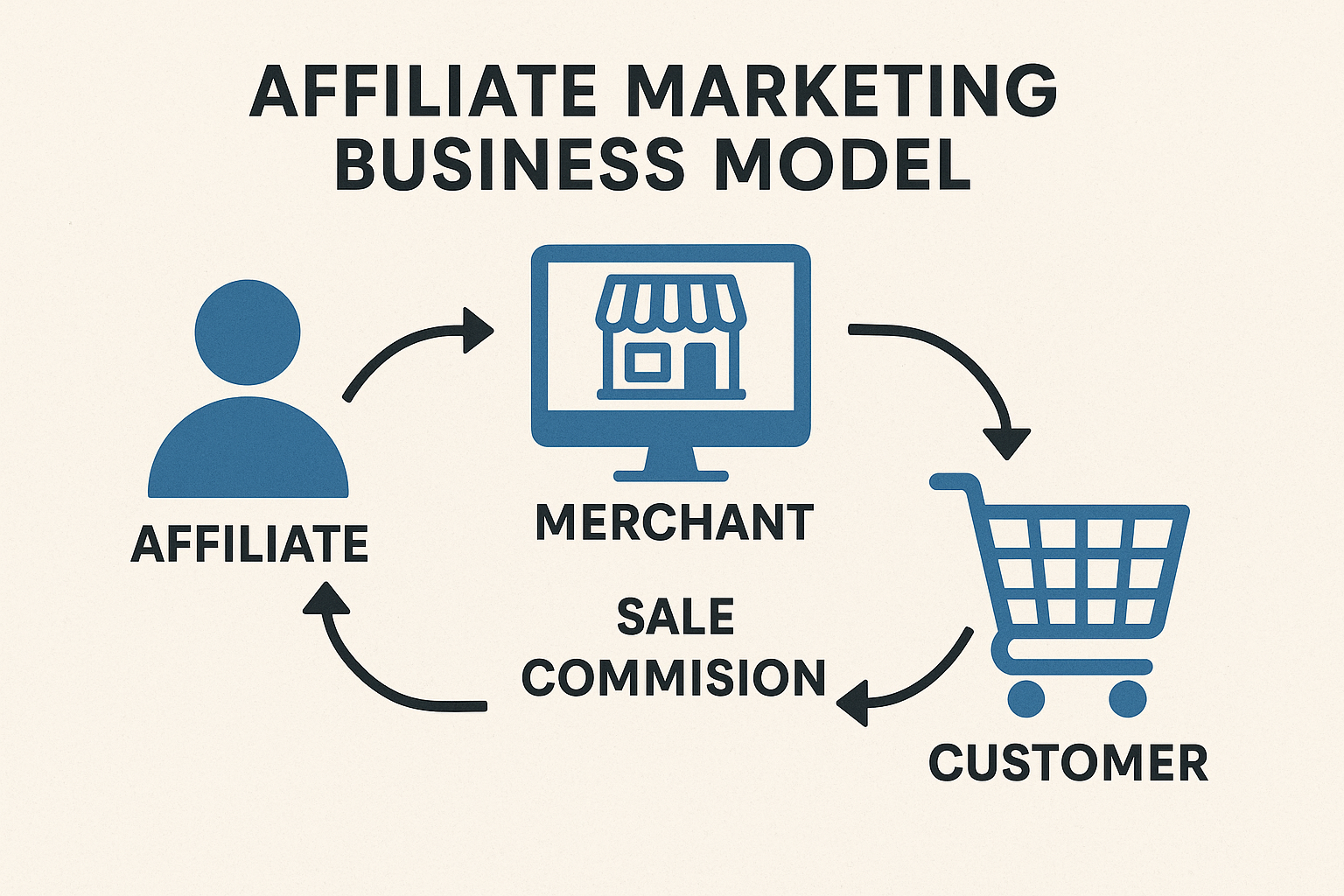
Everyone wins: the merchant gets sales, we get commissions, and the customer gets honest recommendations about products that could help them.
The secret sauce? Finding the sweet spot between what your audience needs and what products actually solve their problems.
Let me get super specific about commission structures, because this is something that threw me for a loop at first. Most programs fall into these payment models:
- Pay per sale (most common): You might get anywhere from 5% to 50% of the sale price. I’ve seen digital products offer up to 75%! My first affiliate commission was a whopping $1.50 from Amazon, and let me tell you – seeing that first commission notification felt amazing.
- Pay per lead: Some companies pay you when someone signs up for a free trial or newsletter. These might range from $1 to $100 depending on the industry.
- Pay per click (rare these days): You get paid for sending traffic, regardless of sales.
Here’s a real-world example that blew my mind: Pat Flynn from Smart Passive Income reportedly earned over $100K in a single month promoting Bluehost hosting services.
While that’s definitely not typical (keeping it real here!), it shows what’s possible when you build genuine trust with your audience.
Something nobody tells beginners: the technical setup can be a bit tricky. You’ll need to wrap your head around affiliate links, tracking cookies, and sometimes even API integrations.
I spent a whole weekend figuring out how to properly disclose affiliate relationships without making my blog posts sound like legal documents.
Speaking of disclosure – here’s a crucial tip: Always, always, ALWAYS disclose your affiliate relationships. It will build trust with your audience. I’ve found that being super transparent actually increases conversion rates because people appreciate the honesty.
The best part about affiliate marketing? You can start literally today. No need to create products, handle inventory, or deal with customer service.
Just focus on providing genuine value and helpful recommendations to your audience. Sometimes the simplest approach works best – I’ve had more success with straightforward, honest reviews than trying to be clever with my marketing.
Remember though – this isn’t a get-rich-quick scheme. It took me weeks to earn my first $100. But stick with it, focus on helping your audience, and the commissions will follow. Trust me on this one!
I know this might seem like you would need a lot of time to build a considerable stream of income with these low commissions. But when you start getting into it, you will realize that you can make good money even with lower commissions.
Don’t take my word for granted. Just have a look at my income report and see how I made $6k in one month by running low ticket programs.
And there’s more!
Lots of companies offer way higher payments, usually for very premium services, where you can actually earn $1,000+ per sale.
If you are interested to know more about this you can read my guide about high ticket affiliate marketing.
Effective Marketing Strategies for New Affiliates
Let me tell you about my journey with affiliate marketing strategies – and hopefully save you from some of the painful (and expensive) lessons I learned when starting out!
While most people know that affiliate marketing involves promoting affiliate products, the majority of them don’t know that there are multiple ways of doing this.
I don’t want to put any limits as anyone can find his or her own way to do affiliate marketing; but generally speaking there are 3 main strategies one could pursue:
- Blogging
- Media Buying
- Influencer Marketing
—
1. Blogging
Blogging is probably the most known way of doing affiliate marketing.
By publishing posts on your blog you can add affiliate links potentially anywhere and monetize from these. The possibilities of earning passive income with a blog are multiple and can be very profitable.
Now you won’t become a millionaire overnight, but you can rest assured that starting a blog is a low risk and potentially highly lucrative fun thing to create to build passive income into your life.
Here’s a short 5 step guide on how to start your blog.
Further reading on FiloAffiliate.com: Here you can find a more comprehensive guide on how to start an affiliate marketing blog that will help you grow your income.
Step 1: Set Up Your Website
The first thing you want to do is choose a name for your website.
And the best name for your website (your domain name) is your own name!
Why? Because it’s flexible and adaptable. Using your name (or a variation like I have done with my blog filoaffiliate.com) allows you to shift your content strategy without limitations.
A name-based domain builds trust and credibility.
Starting with your name is the smartest way to create a long-term, adaptable, and successful blog.
So don’t overthink this process, just do it!
After you pick up your name, it’s time to choose a web hosting.
The best platform by far to build your blog on is WordPress, and the best host you need to get started is Bluehost.
You are lucky, as right now they are having a promotion, and you can get started for just $1.99/month!
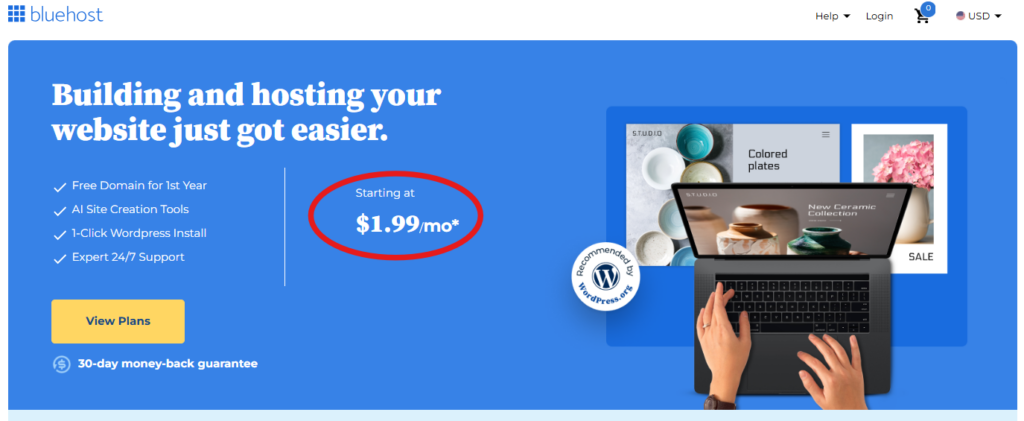
I actually use Bluehost myself and recommend them to anyone who wants to start blogging.
- They are one of the cheapest options on the market.
- They have a 30-day money-back guarantee.
- It’s super easy to setup.
- They’ve been in the space and collaborating with WordPress since 2005.
- They have 24/7 support.
Make sure you use my Bluehost link to get started at the crazy price of $1.99/month (75% off).
Step 2: Choose Your Niche
Your blog niche is simply the specific topic your site focuses on. It could be anything from photography to interior design, fashion, or even niche professions like gardeners or make-up artists.
My niche for example is how to start with affiliate marketing.
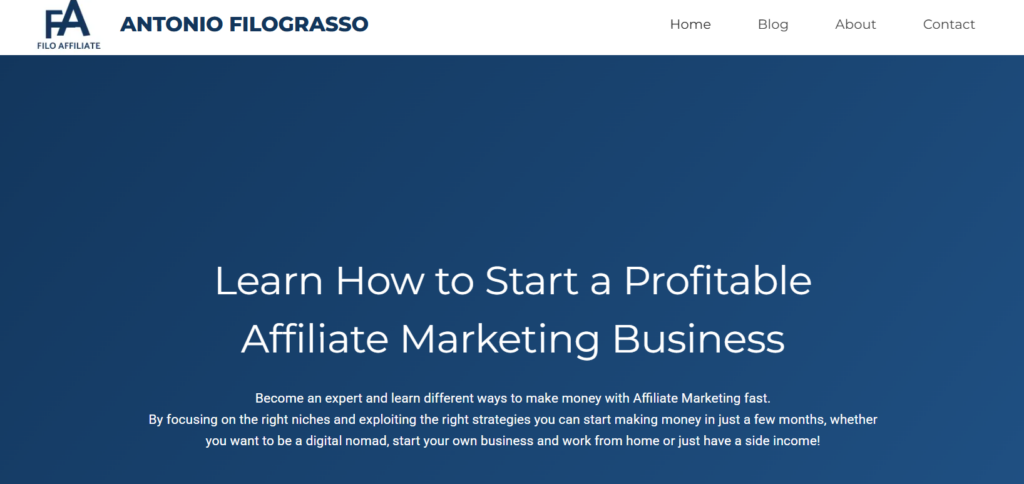
I teach how to start an affiliate marketing business and how to make money with it.
My entire blog is around affiliate marketing.
Why Your Blog Needs a Niche
Google favors websites with a clearly defined focus because it makes it easier for search algorithms to understand what your site is about—and rank it accordingly.
It also just makes sense. You’re unlikely to be an expert in a dozen different fields. People specialize, and your blog should too.
Gone are the MySpace-era days of blogging about whatever pops into your head—“Hey, I just had coffee!”. “I’m listening to the new Oasis song!”.
While your blog is yours, its success depends on the value you provide to others. Today, blogging is driven by Google’s rules, and to succeed, you need to play by its rules.
Start With a Sub-Niche
Many aspiring bloggers say, “I want to start a fitness blog” or “I want to write about fashion.”
That’s a great start, but it’s too broad.
If you go after a general niche like health or fitness, you’ll be competing against massive sites with billion-dollar budgets. Outranking them in search results? Nearly impossible. Outspending them on ads? Not happening.
Instead, niche down first. Find a smaller, more focused segment within your niche to establish yourself—then expand as you grow.
Step 3: Keyword Research
Once you have found your own niche, it’s time to plan your content strategy.
The main goal is to find keywords to rank your blog and build topical authority.
Once you have them, you’ll know exactly what to write!
How to Do Keyword Research
When searching for keywords, you can pursue two different ways:
1. Use free tools to find key-terms relevant to your niche
One easy way of finding trending topics or keywords is to use social media platforms. Think about X, Facebook, LinkedIn.
Here you can look at the newest posts around your niche to find out what people are talking about and use this to your advantage by writing articles about it.
If it’s about new topics or emerging trends, the competition on those keywords will be very low at the start, which will give you a competitive advantage in the long term.
2. Take advantage of paid tools like Ahrefs or SEMRush
First and foremost you need to start ranking for low-competition keywords.
Keep in mind that you are a new blog. There’s a bunch of older, bigger blogs above you and it will be impossible for you to compete against them!
So how do you beat them?
You start by finding low search volume keywords that other websites haven’t bothered with or haven’t optimized properly.
OK? Here’s how to do it.
How to Use Ahrefs to Find Low Competition Keywords
All you’ll need to do with Ahrefs is enter in keywords related to your niche, and this tool will show you some amazing information that helps you determine exactly what to write about to rank in Google:
- Keyword Difficulty: How hard it is to rank for this keyword.
- Volume: How many people are searching for this keyword.
- Traffic Potential: A rough estimation of how much traffic the #1 page receives for this key term (and all other key terms it ranks for).
- Global Volume: An international breakdown of traffic by country.
Now the most important part of this tool is that it also gives you a ton of helpful keyword ideas and similar terms.
Let’s take the camping niche as an example.
All you need to do is type camping, or another keyword connected to your niche but still broad like camping checklist into Ahrefs and click the “matching terms” button in the top left corner:
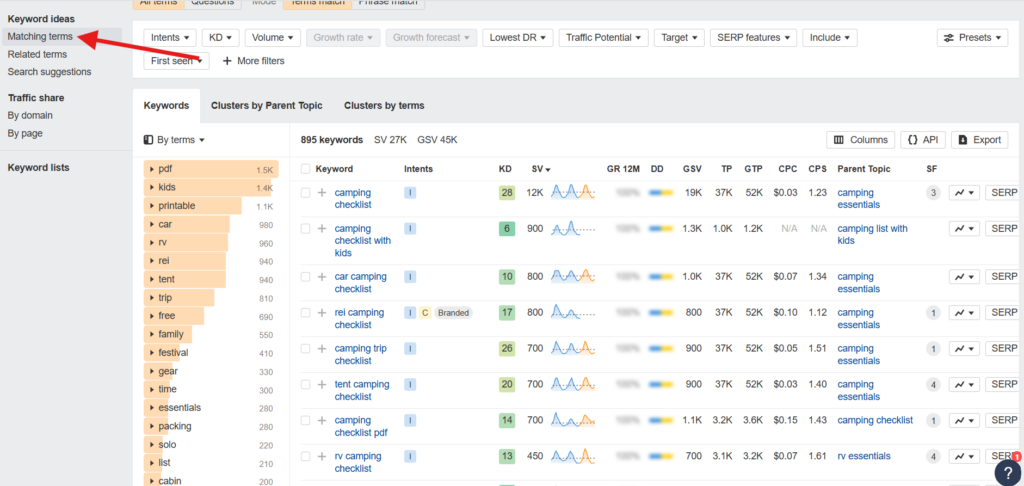
DONE!
Now you have a lot of great blog ideas!
As you can see it’s way easier than you think.
Next step is to find the right topics for your blog.
The first thing you want to do is to look at the KD or “Keyword Difficulty”.
This number defines more or less how hard it will be to rank for that specific keyword. Typically for new bloggers, you don’t want to go over 15-20.

Lots of very good blog ideas to write about. Take the second one as an example, camping checklist with kids.
- It has a KD of 6, so it would be rather easy to rank for this keyword
- The Search Volume (SV) is 900. This means you get on 900 average monthly number of searches for this term. Plenty enough to start getting some good traffic to your post.
Ideally you want to start with 5-6 blog posts:
- 3 informational posts: These are used to inform your audience and help other articles rank better by giving you more authority with Google.
- 2 transactional posts: This is where the money comes from. Usually product reviews like “best camping gears for beginners”.
- 1 post about your story (this is not strictly necessary and you might include this in your about page)
Once you have your first blog posts live, it will be much easier and invigorating to write 10, 20, 50 and more.
Trust me, it’s really an amazing feeling!
2. Media Buying
We have briefly explored how to start a blog for your affiliate marketing business.
If writing is not your strong suit, media buying could be a better idea.
The basic concept is exactly the same as doing affiliate marketing through blogging: you get paid if someone completes an action (a purchase or signing up for a service) by using the links you provide.
The main difference is that you are going to run paid advertising campaigns.
Here’s an easy 4-step Media Buying guide for beginners
Step 1: Choose Your Traffic Source
A traffic source is basically the platform where you advertise. The main types include:
- Social (Facebook, Instagram, TikTok, etc.)
- Search (Google, Bing)
- Native (Sponsored content on platforms like Taboola, Mgid)
- Push (Push Notification ads from platforms like Richpush)
For beginners, Facebook (and Instagram) is the best option due to its ease of use, budget control, and effectiveness in paid advertising.
Other sources require more experience.
If you are interested in this topic you can also read my article on The Best Traffic Sources.
Step 2: Sign Up With Affiliate Networks
Affiliate networks act as intermediaries between affiliates and advertisers, providing access to products and services to promote. These networks manage relationships, making it easy for affiliates to find and promote offers.
Best thing about affiliate networks? Getting in contact with them is super easy.—register on their website, chat with a representative, and get accepted.
Once in, you gain access to a variety of affiliate programs and promotional materials.
Step 3: Choose Your Vertical
A vertical is a market category, such as Ecommerce, Insurance, Finance, or Gaming.
Within each vertical, there are specific offers (e.g., Car Insurance, Health Insurance).
Each of these offers has a unique link provided by the affiliate network, which you are going to use to run your campaigns.
If you want some advice, beginners should start with verticals they are familiar with and test 2-3 different offers.
While experts know the top-performing verticals, success ultimately depends on continuous testing to find what works best.
Step 4: Track Your Results
Tracking is essential in affiliate marketing. While paid third-party tracking platforms exist, many affiliate networks offer built-in tools to track campaign performance.
These tools help analyze metrics and optimize results.
By leveraging network tracking features, affiliates can monitor data effectively before investing in external tracking solutions, which can be quite expensive.
3. Influencer Marketing
Your third option for affiliate marketing could be Influencer Marketing.
To be honest, this is my least favorite option and I personally think it’s also the hardest to pursue.
But if successful, this strategy would generate money faster compared to blogging or media buying.
More on this later… First things first: what is influencer marketing?
Influencer marketing involves partnering with individuals who have established credibility and audience in a specific niche to promote products or services for a given commission.
Just like any other affiliate marketing strategy, influencers can sign up for affiliate programs, where they get a link that they can place on their YouTube videos, Instagram, or TikTok for example.
And you could do the same, after you have built a community of followers.
Do you see now what’s the main problem with this strategy and why I think it’s the hardest?
Let me break it down for you.
Doing affiliate marketing in this way involves much more work than you can imagine. For a very simple reason. You need traffic to make money, or in other words, you need a community of people constantly visiting your YouTube channel, Instagram or TikTok profile.
But guess what? Very few people are bloggers or YouTubers, with many people following them. So before you start making money, you’ll need to build a continuous stream of readers/followers.
But as you know, that is not an easy thing to achieve. Even if you are trying to be a micro influencer, it takes time to have 10k-20k followers.
On the other end, if you are able to build a community of people that follow you the results will be much more successful.
In other words, it will be easier for you to earn money.
Wonder why?
Because you are promoting something to people that have already built trust in you.
You need very little to no convincing most of the times, which makes it easier to sell something to these people.
And this is why I say that this strategy can be the fastest to make money with affiliate marketing.
Conclusion
Affiliate marketing might sound a little fancy at first, but it’s really just about sharing stuff you like and helping others find it, too—and getting paid for it!
If you’ve got a passion for something (anything, really!), and you’re willing to learn, stay consistent, and show up regularly, you can totally do this.
Just remember, it’s not a get-rich-quick thing. It takes time, patience, and a little trial and error. But once you get the hang of it, it’s pretty awesome to see the pieces come together.
So take that first step, keep learning, and don’t be afraid to try new things. You’ve got this!





